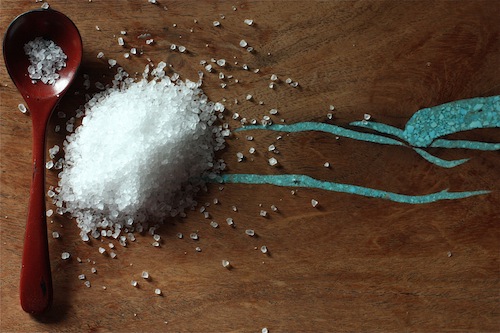
by Rachael White, Hosting Expert for the Menuism.com Hosting and Entertaining Blog
Photo by Rachael White

The simplest, most humble and perhaps under-appreciated ingredient in kitchens around the world is salt. A pinch can transform a dish, bringing depth of flavor to what would otherwise be bland and boring. It can be surprisingly easy to take such a simple substance for granted, ignoring the fact that it goes beyond the typical salt shaker coming from exotic places like Salta, Argentina and Hokkaido, Japan. Salt comes in different colors, sizes and flavors that are exciting to explore. As with wine, salt can be paired with food to showcase its unique flavors making it the perfect theme for your next party. Here are some ideas to increase your salt knowledge and get your own salt tasting party underway.
What's the difference?
You may be wondering what separates one salt from another. While subtle, the differences may surprise your tastebuds. Red Hawaiian salt, for example, can be more mild than traditional salt. Others, like black sea salt, offer a subtle smokiness. Texture is another factor. Grey sea salt often contains more moisture, changing the mouth feel. Pink sea salt may have larger granules that add a little crunch to a dish. Flake salt, perfect for finishing, dissolves on the tongue softly. The fun part about all these different types of salt is that there are no rules. Sure, there are classic combinations (fleur de sel caramels, for example), but the options are endless. Experiment with different combinations and share your discoveries with your guests.
Choosing Salts: Deciding which salts to feature for your tasting is a perk of being the host. There are no rules here, but if you like guidelines to help with the decision-making process you can stick to salt from a specific region like Hawaii, South America, Asia or Europe. Another option would be to create a theme around the color of your salts. For example, you could try pink sea salts from different regions, focusing on the subtle differences created by each environment. If you have the time, you can do a combination of these themes. An easy combination to use, especially for beginners, is simply using three types of salt like white, red and black. There are obvious contrasts that are easy to pinpoint. If there is enough interest, you can expand to a greater variety of salts at a later date.
Create Pairings: Once your salt selections are made, be sure to taste them all individually. This will help you create the best pairings to serve at your event. Take notes as you taste each salt. Is it mild or strong? Smokey or floral? Close your eyes and hold the salt on your tongue, focusing on the immediate impact and then how the salt changes its flavor as it sits on your taste buds. Which part of your tongue picks up the flavor of the salt the most? If tasting the salt on its own is too much for you, simply sprinkle it on a piece of bread spread with a tiny bit of unsalted butter. This gives you a base palette to use as you taste, allowing you to pinpoint the unique flavor of each salt. Once you've taken notes, use them to help determine what pairings you'd like to make. For example, if a salt has a smoky flavor, consider pairing it with a creamy pasta to help showcase the salt's unique taste.
How to Present: The easiest and best way for your guests to learn and experiment is to serve the food sans salt. Instead, give each guests a small dish for each salt. Guests can then sprinkle the salts on each dish as they eat, deciding which is best with a particular food. Also, provide diners with notepads and pens so they can record their thoughts on each combination. Have a discussion at the end of the meal about the salts, if you like. This is also a great time for guests to share their thoughts on what other foods would pair well with each salt.
There is a big world outside of table salt and having a salt tasting party is just one way to delve into the unknown with your friends. If you're looking for ways to purchase sea salt, there plenty of online resources such as Salt Works. It is also very easy to find basic varieties of sea salt at many grocery stores nowadays, which are perfect for beginners. Now, go explore the world of sea salt and share your discoveries by hosting your own salt tasting party. Cheers!
Related links from the Menuism Hosting and Entertaining Blog:
• Canning Party Can-Do
• Tips and Ideas for Hostess Gifts
• How to Throw a Holiday Party on a Budget
Salt Tasting: A Pinch of Perfection originally published on the Menuism Hosting and Entertaining Blog.
Rachael White is an American foodie living in Tokyo. For two years, she and her husband have been exploring the ins and outs of the fascinating food culture of Japan. Rachael's blog "Tokyo Terrace" chronicles her experiences creating dishes and drinks that use new and exciting flavors in accessible ways. She has been published in Tokyo's Daily Yomiuri Newspaper and contributes to JapanEats.tv. Originally from Minnesota, Rachael creates recipes that reflect Midwestern comfort food with a modern, Asian twist.